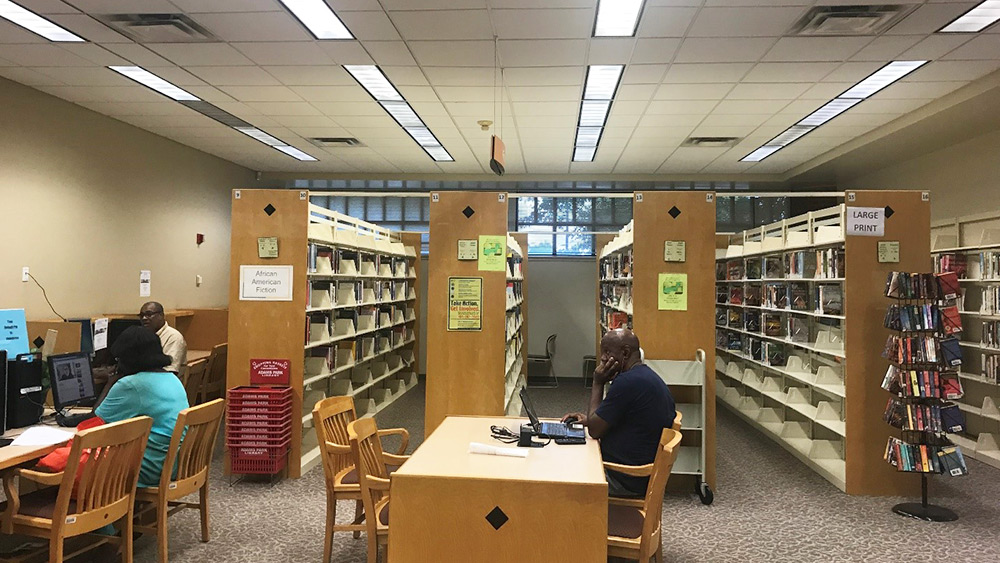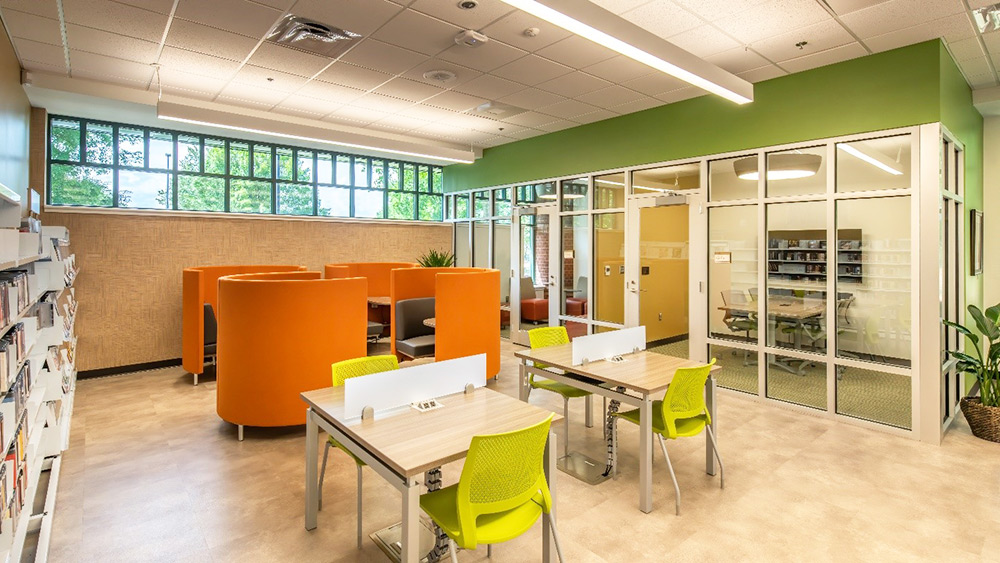The following is an informal transcription of this episode of the Advancing America’s Libraries Podcast.
How is your space organized? Are your tools easy to access? Does your space still serve the purpose that it was originally planned for? In other words, has technology changed the way you do work?
Maureen Arndt
Pam: I am pleased today to introduce Maureen Arndt, AIA, IIDA, of 720 Design Inc., a boutique planning, architecture, and interior design firm devoted to the development of modern library spaces. Maureen has a national profile in the library world and has worked on projects as diverse as Frisco, Texas, and Buncombe, North Carolina. Welcome, Maureen!
Maureen: Thank you, Pam! I'm so happy to be here with you this morning.
Pam: You and I have worked on a variety of public library projects with The Ivy Group at the research and strategy portion and you at the site selection, space planning, design, and architectural end. I think of our work as a continuum starting with the community needs and then evolving into service delivery. What I'd like to do today, and I know this is your area of specialization, is to hone in on one dimension of your work that is often overlooked. Forget renovation and reconstruction. How do you do better with the space you already have?
Maureen: That is so true, Pam, and I think there are really two reasons for it. The first is one way to gain space is to move shelving, and that's a really big job. And the second is that we become accustomed the challenges in our own space. We get used to it. We work around it. We think of it as just the way it is. In some ways it can be challenging to see the forest through the trees.
Pam: Let's start with the outside of the building.
Outdoor spaces are valuable assets.
Maureen: In addition to really being the first impression of the library, this is a space that can be an expansion of the interior space. It is space where you can expand your programming and service opportunities. I think the outside of a building is relevant in today's world especially when schools are closed for COVID and such as large percentage of our population still does not have good access to the internet. So how can we use the outside of the building to really expand library spaces?
In buildings we are planning right now, we're looking at using the outdoor space to expand seating, to make it a more useable area, to provide lighting for safety and security, to provide power, and especially to provide access to Wi-Fi 24-hours-a-day. That way the library can become a 24-hour space for those who really need access to the internet.
Gain space by replacing service desks with kiosks.
Pam: And how about as you enter the building?
Maureen: Typically, the first feature you see when you enter the building is the service desk. If your building was built prior to ten years ago, your service desk is big. We've just completed working on space planning for six relatively small branches in Fulton County, Georgia. The very first strategy we implemented was to replace the big service desk with a small centralized staff kiosk. Some of these buildings have gained 300-400 square feet back into the public service area which is HUGE in a branch that is only 6,000 square feet. What it also means is that you are rethinking how staff work and how to provide adequate and efficient workspace.
Circulate rather than house books.
Pam: You've already said this, Maureen, but I don't think you can emphasize it enough. Libraries, by their very nature, devote a great deal of space to shelving books.
Maureen: Of course, they do. Books are still the brand; however, this is an opportunity to learn from retail. The goal after all isn't to house the books but to get the books into your library customers' houses. We know from retail that items shelved at eye level are the best sellers. A shelf that is too crowded is difficult to find what you're looking for. So, lowering the shelving, keeping the shelves 66-75% full, and using some of the face out shelving will increase the circulation. If the books are checked out, you can have more in your overall collection.
Pam: Are you suggesting weeding the collection? Storing it elsewhere? Rotating it?
Maureen: No. I'm suggesting getting people to check more things out!


Make room and save costs by minimizing storage.
Pam: What about staff space? Staff, often quite rightly, say, "I just don't have enough workspace...enough storage spaces."
Maureen: There never is enough storage space. Just like in our houses, we fill up whatever storage space we have. I think the biggest is that library staff is so generous. When we're planning buildings, staff will always give up their own space to provide more for their patrons. There is a balance, however. For staff to really provide the best possible service to their guests, they need adequate space to accomplish their tasks efficiently.
Pam: Maureen, what about the Marie Kondo phenomenon? Can we apply it to librarians?
Maureen: Absolutely we can apply the Marie Kondo "tidy challenge" and apply it to the library space. A lot of current theories have to do with visualizing what does your ideal workspace look like? This is something we talk about during library space planning. What is the order in which you do tasks? Is your staff space laid out to accommodate accomplishing those tasks in the most efficient order? It's a lean process.
So, looking at how your space is organized; are your tools easy to access; does your space still serve the purpose that it was originally planned for? In other words, has technology changed the way you do work? Has your job description changed which means re-laying out how your space is used?
I was visiting a library recently, and they were short on space. They had dedicated an entire office to storing broken book carts because the book carts are expensive. When I talked to them about how much new construction costs—in some places about $400/sq.ft.—and they were using 200 sq. ft. to store broken carts, what was the cost of that space being used for broken carts?
Pam: What a great exercise that is! So, you can apply that to almost any kind of space utilization, right?
Maureen: Absolutely, and you need to think about it that way. There is a cost to storing things that may exceed the value of what you're storing. When you think about it that way, you can look at your storage spaces in new ways.
Pam: Librarians always believe in, "Use it up, wear it out, make do, or do without." In this case, do without those things that are more expensive to repair.
Maureen: It's true, and we live in a "just in time" world as well with same-day shipping from Office Depot or Amazon. Maybe we don't need to store so many office supplies! So, you're really evaluating your storage which becomes critical when you're short on space in general.


Find space by right-sizing, decluttering, and adding light and color.
Pam: If you give three specific recommendations to libraries to find space where they don't think they have space, what would they be?
Maureen: The first thing I would look at is just right-sizing and balancing your collection. What's changed over the years about your community? That may mean you're oversized in one area and undersized in another. How can you rebalance? Maybe you need more space in fiction whereas non-fiction hasn't been checking out very well. How can you rearrange your collection to gain more space for the space you really need?
The other important recommendation I would give is based on the six libraries we just renovated (in Fulton County). Looking at before and after pictures, you can see the difference that just decluttering does. What is hanging on surfaces or sat upon? What donations have you accepted that no longer fit the vision for your space? What are your goals on how you want to use your space?
We're working with a library in north Texas right now that is getting ready to recarpet. As part of this project, we are helping them re-space plan the entire building. The fiction area is a space they are short on. We are looking at different ways to arrange the shelving to increase the capacity without adding on to the building. Just by rotating the shelving 90 degrees we were able to fit 40 additional sections of shelving in that area. Because of the recarpeting, the shelving was being moved anyway so it was an easy way to rearrange and add space without adding on the building. It is also a great way to declutter when you recarpet or do that kind of move. Taking out all the visual clutter in a space really does make it feel bigger, more spacious, and more inviting.
Pam: And your third recommendation?
Maureen: The third suggestion is adding light and color. Lighting is one of the most important aspects of library design. The type and level of lighting can completely change how spacious a library feels. For example, when you use light fixtures that shine up onto the ceiling, the ceiling becomes light and bright. It makes the ceiling feel taller and the whole space more voluminous.
Then adding color...libraries are big, open spaces without a lot of walls. Unlike a living room in your house, where color can become overwhelming, a library can accept a lot of color, and it changes the whole feel of things.
Communities deserve attractive, well-designed libraries.
Pam: Maureen, it's been great talking with you today. I love the work we've done together, and, as you mentioned Buncombe County earlier, maybe you can talk a little bit about what we're doing there.
Maureen: Sure! We're working on a facility master plan for Buncombe County and evaluating each of their buildings. We're looking at whether the branch is still useful, whether it should be replaced, whether it should be renovated, or whether some of the branches should be combined into regional libraries for more efficient library service. I'm excited to work with you on that project as well, Pam.
I've spent my entire career working on library projects. It has been a great joy to really impact communities with the most efficient and best possible service.
Pam: It's one thing to love your work and another to love who you work with.
Maureen: When you get to do both, it's pretty amazing!
Pam: Thanks for joining us today. To see examples of Maureen's terrific work with libraries, you can look at the transcript of this podcast—photos will be included there, and you can visit her website, 720design.net. Maureen, it has been a great pleasure.

Thank you for listening to another episode of the Advancing America's Libraries Podcast. If you have any topic requests, tweet us @IvyGroup or email contact@ivygroup.com.
Category: Libraries
Tags: facilities, libraries, podcast